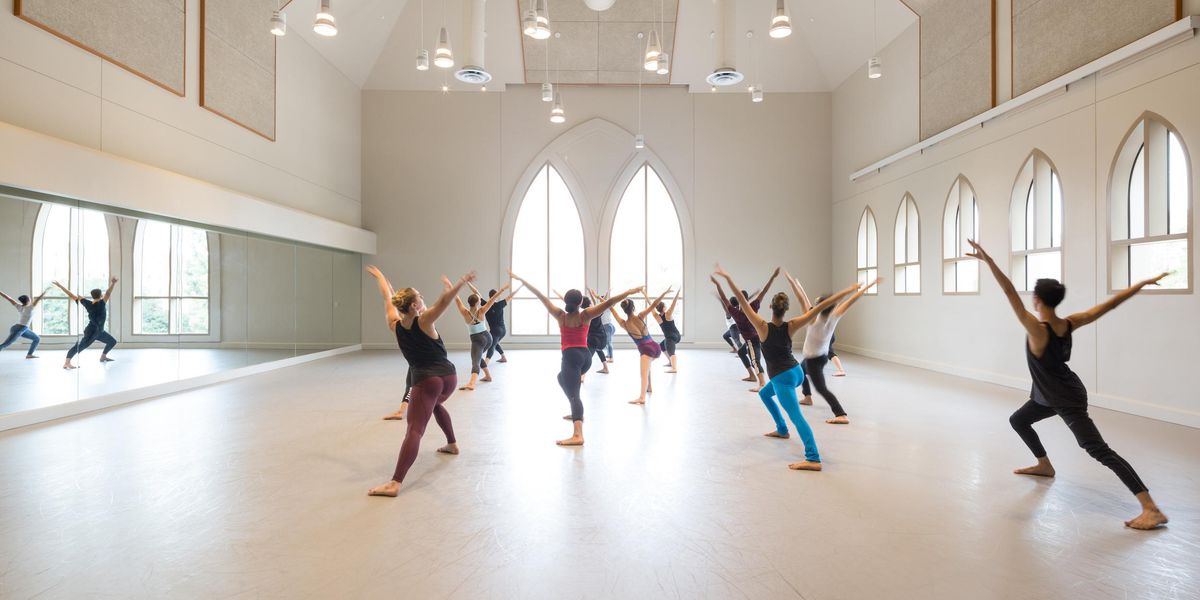Centerwork: Capoeira
The Brazilian tradition that’s sweeping through American dance.
Tiba Vieira’s capoeira class at the Ailey studios. Photo:
Kyle Froman, Courtesy Ailey
About halfway through a beginner capoeira class at the Ailey Extension, students pair off to put the movements they’ve been developing into practice. The instructor, Tiba Vieira, lightly pounds a tall, wooden drum to keep the time. Facing one another, the men and women rock back and forth low to the ground until one executes a surprise roundhouse kick, forcing the other to lunge and duck or spin across the floor.
“You’re gonna get a free haircut,” Vieira quips after one student just barely clears his partner’s sweeping leg.
Capoeira is a Brazilian martial art dating back to the 16th century, when it’s believed African slaves began disguising their self-defense training as a dance. “We say we dance like a fight and fight like a dance,” says Vieira, who’s been teaching and performing the style for almost two decades. “The movement requires you to be strong and tough, but delicate at the same time.” That unique combination has attracted the attention of the modern dance world in recent years. Choreographers like Ronald K. Brown and Larry Keigwin have infused their work with hints of capoeira, and dancers have discovered the benefits of studying the form.
A typical class begins with a warm-up followed by a succession of elements of simulated combat, starting with the ginga, a foundational swinging movement. (See sidebar.) From there the students learn various kicks and strikes as well as defensive moves like dodges and rolls to react to their partner’s attacks. At advanced levels cartwheels, flips, and other tricks are added to the mix.
Dance Brazil. Photo:
Sharen Bradford, Courtesy CAMI
But once you break into pairs to play (capoeira is characterized as a game of fakes and feints as opposed to a contact sport), there are no set sequences to fall back on. It’s entirely improvised. “There’s a lot of room for personal expression,” Vieira says. “Once you learn the rules you can break them and bring creativity to it. You don’t have to move exactly like everyone else.”
This is one of the big advantages for classical dancers, says Kamilah Turner, a ballet dancer turned capoeirista who is currently the sole American member of Dance Brazil. (Founded by Jelon Vieira—Tiba’s uncle and teacher—Dance Brazil has toured the U.S. for more than 25 years.) Turner was introduced to the style as a member of the Cleo Parker Robinson Dance Ensemble in Denver, where she danced for five years after a stint with Urban Bush Women and touring with the Broadway show Aida. “Growing up I wasn’t exposed to improv,” she says. “As dancers, we always want to be prepared before we get out there. But with capoeira, you’re constantly in the moment. It helped me learn to move without thinking so much.”
And the movements themselves are nothing like classical technique. “In ballet everything is up, up, up,” says Turner. “But in capoeira you have to get grounded and feel the earth and maneuver yourself around people.”
Leandro Silva, director of New York City–based Silva Dance Company, agrees. “It’s a different type of strength and coordination,” he says. “In capoeira there’s a lot of changing levels—going to the floor, coming up to a jump and torque, and then going back to the floor.” Silva also teaches at Steps on Broadway, where, he says, many professionals take his class to improve the flow of their dancing. “It’s beautiful to see a dancer do 300 turns, but to do 300 turns and flip in the air and connect the two movements without stopping—that takes you to a different level.”
Dance Brazil in Jelon Vieira’s
Batuke (2011). Photo: Sharen Bradford, Courtesy CAMI
Other dancers study capoeira for the physical workout. Vieira notes that many classical and contemporary dancers lack upper body strength, something capoeira demands. With its acrobatic elements, “your hands become another set of feet,” he says. And since it’s all about timing, capoeira can also help dancers with partnering. Eye contact and control is essential. “They kick and you respond with another kick or move away,” says Vieira, likening a game to a conversation. “You can feel the person. Two people become one.”
Turner says capoeira has made her a stronger dancer inside and out. And that’s why no matter what her future holds after Dance Brazil, she will keep playing. “It’s so much bigger than anything I’ve done,” she says. “Capoeira is a part of me now.”
Elaine Stuart is an NYC writer who has covered dance for
The Wall Street Journal and The Brooklyn Rail.
Capoeira “Cliffs Notes”
Many dance studios have added capoeira to their roster. Here are a few terms you might hear in class.
Ginga:
“The soul of capoeira,” as instructor Tiba Vieira puts it; all other moves are built upon its rocking motion. A low, swooping side step (from a wide fourth on one side to a wide fourth on the other) with torso opposition, the ginga’s purpose is to ground the body and prepare it for more elaborate movements.
Atabaque:
A large Afro-Brazilian hand drum, traditionally made of Jacaranda wood and calfskin, that’s often used by instructors to establish rhythms and lead songs. Most classes don’t have independent accompanists; capoeiristas are expected to play the indigenous instruments—like the atabaque, berimbau, pandeiro, and caxixi—as part of the form.
Roda:
The circle in which capoeiristas face off; two dancers play in the center while those on the perimeter clap, sing folk songs, and watch for an opening to take their turn. The dancers replace each other seamlessly, moving in and out of the circle like liquid. Vieira often uses the image of water to describe the quality and philosophy of capoeira, because “it finds its way around anything.”




